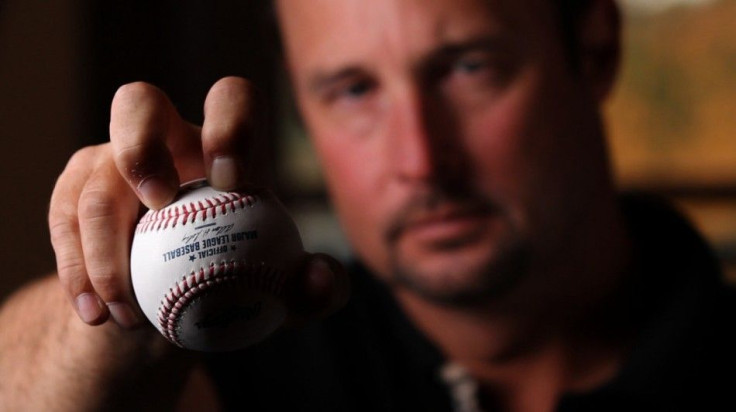The 'Knuckleball!' Movie And Keeping A 'Dying Pitch' Alive
REVIEW

The greenroom at the premier of Knuckleball! -- Ricki Stern and Anne Sundberg's new documentary about the 2011 seasons of pitchers Tim Wakefield and R.A. Dickey -- is a lot like a major league locker room, only a lot smaller. Tucked behind the men's room on the first floor of the World Financial Center in downtown New York, the mirrored room is lit by florescence and full of reporters. There are folding chairs and tables with snacks and, in what could be reminiscent of the Rod Sox clubhouse in Wakefield's final season, a bottle of Vodka.
But more than the physical similarities is the atmosphere of the premier at the Tribeca Film Festival. Like opening day at Fenway or Citi Field, the concourse outside the greenroom is full of excited and expectant fans, many participating in organized festivities like a trivia contest and a pitching clinic for kids. Even Mr. Met is there.
And while the pitchers in the movie downplay the similarities between tonight's screening and starting a professional ball game in front of 40,000 people, they admit they are nervous about watching themselves and their work in a feature length movie, which is a first for both. It's a different kind of anticipation, but anticipation nonetheless.
It's different ... I'm a little nervous tonight because I'm in a totally different arena then what I'm used to. It's a lot of fun, but I'm anxious to get the film underway to see peoples' reaction to it, and see myself on the big screen, Wakefield told me.
Knuckleball! is a movie about what former Yankees pitcher Jim Bouton calls a dying art. The pitch itself is a freak, one that goes against the ethos of baseball, yet, when it works, it can confuse even the game's best hitters. But after Wakefield retired at the end of the 2011 season, Dickey became the last knuckleball pitcher in the major leagues and he, along with the half-dozen retired knuckleballers that are still alive, fears that he might not have a successor.
One of the most amazing revelations from this amazing documentary is that, more so than any other baseball payers -- and probably any other athletes -- these pitchers feel like they are part of a select club. And they are. One even senses this in person, and when talking about their own careers, Wakefield and Dickey often mention knuckleball legends like Charlie Hough and Phil Niekro, who will themselves mention Wakefield and Dickey when they are being interviewed. Knuckleball pitchers often use the words fraternity and lineage, and those words fit.
I never meet R.A. Dickey before today, but the minute we shook hands and said 'hello' we knew were in the same club, Bouton told me at the premier.
That's because the pitch itself is such an anomaly. It's a last resort taken by players who have little other hope of staying in the pros. It's partly a pitch of desperation, both for those who have to throw it and for the batters who have to try to hit it.
The goal of the pitch is to not control it, Bouton said. You have to let the ball go ... the ball decides where it wants to go. Sometimes its goes in the strike zone, sometime in the dirt and sometimes right in the center of a bat.
The careers of these players mirror the knuckleball pitch itself. Again, one of the film's greatest strengths is how it shows this. The film moves non-linearly, jumping through Wakefield and Dickey's careers, which, like the knuckleball, go up and down erratically and unpredictably. After taking his first team, the Pittsburg Pirates, to the National League Championship Series in his rookie year, Wakefield lost his spot in the starting rotation in the first month of the following season and his spot on the roster in the next.
Managers either don't like or don't trust the pitch, and so even after throwing a near-perfect game, like Dickey did in August 2010, they sometimes find themselves left of the starting rotation.
Yet, like the knuckleball, their careers are generally unhurried. Wakefield played for a total of 19 seasons, Hough for 24 and, although he seems like a new, young star for the Mets, R.A. Dickey is already in his 12th season in the majors and the 16th since he was drafted.
This is, in part, what bonds them. Filmmaker Ricki Stern believes that there is a common personality trait that comes from the pitch.
They are not superstars, she said. They know they are going to be the anchors, the workhorses of the team. Their story is so universal. They have dreams and they are doing whatever it takes to achieve them.
Eventually, the sun sets on these men's careers like the sun sets in downtown Manhattan, where Wakefield, Dickey, Hough, Bouton, Stern and Sundberg take their seats in the grandstands, which in this case are folding chairs next to the North Cove Marina. And when it does set, they have a new role to play in baseball: to the pass the torch, as Wakefield says, to whoever comes along to take it. There will be someone, especially after kids with major league dreams see this movie, and they will be part of this exclusive club for life.
© Copyright IBTimes 2024. All rights reserved.











